FORMULA1
FERRARi:
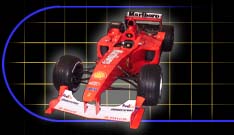

2000 Engine
Model: F1-2000
Engine: 3000 Ferrari (049)
Fuel and lubricant: Shell
Number of cylinders: 10 in V
Cylinder block: Alu die contested
Number of valves: 40
Distribution: Pneumatic
Total displacement: 2,997 cc
Maximum power: > 770 hp
Fuel feed: Magneti Marelli digital
electronic injection
Electronic ignition: Magneti
Marelli static electronic ignition
2000 Car
Drive: Rear
Gearbox: Ferrari longitudinal
gearbox. Limited slip differential
Gearbox control:
Semiautomatic sequential electronically controlled
Number of speeds: 7 +
reverse
Brakes on all four wheels:
Ventilated carbon disks
Suspension: Independent,
push-rod activated torsion spring front and rear
Chassis: Carbon fibre and
honeycomb composite structure
Length: 4387 mm
Width: 1795 mm
Height: 959 mm
Front Track: 1490 mm
Rear Track: 1405 mm
Wheelbase: 3010 mm
Weight with water, lubricant and
driver: 600 kg
Wheels: 13" (front and
rear)
Tyres: Bridgestone
2000 Sponsors:
Marlboro, Shell, FedEx, TICTAC,
Fiat, Magneti Marelli, Bridgestone, Arexons, Brembo, General
Electric, PPG, SKF, Tommy Hilfiger, Momo, TRW Sabelt, Usag, Ve.Ca
Impianti, TechnoGym, Europcar, CR, Champion, CIMA, Lear
Corporation, Officine Meccaniche Rezzatesi, Mannesmann-Sachs,
Mahle, TIM, Valleverde
JAGUAR:
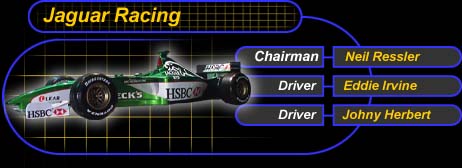
2000 Engine
Designation: Cosworth CR-2
Cylinders: 72-degree
Number of Cylinders: 10
Number of Valves: 40
Capacity: 2998 cc
Power Output: Not Disclosed
Maximum Engine Speed: 18000rpm
Material used: Cast Aluminium
Allow Block and Heads Forged Aluminum Pistons Steel Crankshaft
Engine management system: Visteon
Lubrification system: Dry sump
Ignition System: Cosworth Racing
Spark plugs: Champion
Weight: 97 kg
Dimensions: Length: 569 mm
(22.4in)
Width: 506 mm (19.9in)
Height (including airbox): 492 mm
(19.3in)
2000 Car
Chassis: R1 composite monocoque
structure, designed and built in-house, carrying the
Ford-Cosworth CR2 engine as fully stressed member
Engine: Ford Cosworth V10 CR-2
Transmission: Jaguar
magnesium-cased six-speed gearbox
Longitudinally mounted
High-pressure hydraulic system for
power shift and clutch operation
AP Racing triple-plate pull-type
clutch
Integrated oil system
Front suspension: Upper and lower
carbon wishbones and pushrods
Torsion bar springing
Jaguar/Penske damper layout
Rear suspension: Upper and lower
carbon fibre wishbones and lower highbrid composite steel
Torsion springs
Jaguar/Penske damper layout
Front brakes: AP Racing lithium
alloy six-position caliper. Carbon Industrie carbon fibre discs
and pads
Rear brakes: AP Racing lithium
alloy six-position caliper. Carbon Industrie carbon fibre discs
and pads
Front wheels: 12in x 13in
Rear wheels: 13.4in x 13in
Tyres: Bridgestone
Electronics: Visteon 'VCS' single
box. Integrated engine/chassis electronic control system
Sponsors and Suppliers:
HSBC, MCI Worldcom, Becks, DHL
Worldwide Express, Hewlett Packard, Lear, Bridgestone, Texaco,
Unigraphics Solutions, Visteon, Rolex, S.Oliver, Grants Whiskey,
Barr, Volvo, Sodick, Corporate Jets plc.
BENETTON:

2000 Engine
(Playlife FB02) Engine Type: 10
cylinders (71 degree V10)
Valves: 40
Dimensions: 623 mm (length), 542
mm (width), 395 mm (height), less than 120 Kg (weight)
Management: Magneti Marelli
2000 Car
Chassis: Carbon fibre composite
monocoque manufactured by Benetton Formula 1. Engine installed as
a fully stressed member attached to the rearmost monocoque
bulkhead.
Front suspension: Carbon fibre top
and bottom wishbones, operating a titanium rocker via a pushrod
system. Torsion bar and damper units mounted in the front of the
monocoque. Lightweight uprights an Benetton Formula 1 Racing Team
designed axles.
Rear suspension: Carbon fibre top
and steel lower wishbones, operating coil spring damper units,
mounted on top of the magnesium gearbox.
Transmission: Benetton Formula1
semi-automatic six-speed gearbox. Triple plate clutch.
Fuel system: ATL rubber fuel cell,
mounted in monocoque behind cockpit.
Oil system: Oil tank mounted at
rear of monocoque, providing nine litre capacity.
Cooling system: Separate water and
oil cooling radiators in each sidepod
Electrical: Chassis electronics
and software, including gearbox control developed by Benetton
Formula 1 with interfaces to the Magneti Marelli engine
management system
Braking Systems: Carbon fibre
discs and pads
2000 Sponsors/Suppliers:
Mild Seven, United Colors of
Benetton, Playlife, Marconi, Agip, D2 Mannesmann, Korean Air,
Bridgestone, Sparco, Fluent, Magneti Marelli, Cybex, Komet,
Informix, Charmilles Technologies, Rauch, Lifter, OMB, Action
Minichamps, Novell, Arun Technology, Lectra Systems, PPG Auto
Refinish, Hitachi Seiki, LogiCad 3D, TLT, IMASAF, Bosi, AEA
Technology, PSINet
JORDAN:
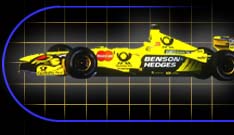

2000 Engine:
Mugen-Honda MF-301HE
Type of Engine: V10 Normal
aspiration
Capacity: 3.0 Litres
Brake Horsepower: Over 770ps (over
566kw)
Overall length: Under 620mm
Overall width: Under 520mm
Overall height: Under 400mm
Cylinder Heads: 4 valves per
cylinder
Valve System: Adopted PVRS
(Pneumatic Valve Return System)
Injection System: Honda PGM-F1
Ignition System: Honda PGM-IG
2000 Car
Chassis Full carbon fibre
composite monocoque
Front Suspension Composite
pushrods activating chassis mounted Penske dampers and torsion
bars, unequal length aerodynamic wishbones, composite top and
bottom wishbones, titanium fabricated uprights and front
anti-roll bar.
Rear Suspension Composite pushrods
activating gearbox mounted Penske dampers, unequal length
aerodynamic wishbones, composite wishbone, titanium fabricated
uprights and rear anti-roll bar.
Transmission In house Jordan GP
design. 6 speed + reverse longitudinal gearbox with
electrohydraulic sequential gear change.
Wheel Base 3050mm
Front Track 1500mm
Rear Track 1418mm
Overall Height 950mm
Overall Length 4550mm
Overall Weight 600kg with driver
Clutch Triple plate Jordan/Sacks
racing clutch
Brakes Brembo braking system
Wheels Forged OZ racing to Jordan
GP specification
Tyres Bridgestone
Fuel Tank Capacity Over 100kg
2000 Sponsors:
Beta, Benson & Hedges, Brother
International, Bridgestone, Deutsche Post, East Digifone, EMC
Corporation, Grundig, Hewlett Packard, Honda Direct Marketing
Corporation (HDC), Imation, Intercond, Keihin, Lucent
Technologies, Mastercard, MiTech, NGK Spark Plug Co. Ltd., OMP,
OS Integration, Pearl Assurance, Pilsner Urquell, PlayStation,
Powermarque, Scania
McLAREN:
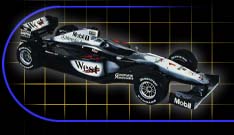
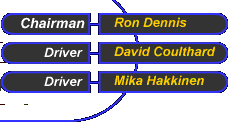
2000 Engine:
2000 Mercedes-Benz FO110J V10
Cylinders: 72 degree V10
Capacity: 2990cc
Valve arrangement 2 camshafts per
bank, 4 per cylinder
Cylinder Block: Cast aluminium
alloy, wet liners
Cylinder head: One-piece sand cast
aluminium alloy
Crankshaft: Steel
Oil system: Dry sump
Ignition: TAG Electronic System
2000 Car
Transmission: McLaren
longitudinal gearbox with semi-automatic operation. McLaren drive
shafts and cv assemblies
Chassis: McLaren moulded carbon
fibre/aluminium honeycomb composite incorporating front and side
impact structures. Contains integral safety fuel cell
Front Suspension: Inboard torsion
bar/damper system operated by push rod and bell crank with a
double wishbone arrangement.
Rear Suspension: Inboard torsion
bar/damper system operated by push rod and bell crank with a
double wishbone arrangement.
Dampers: McLaren
Tyres: Bridgestone
Race Wheels: Enkei
Construction: One-piece side pod
and engine cover. Separate floor section, structural nose with
integral front wing.
Fuels: Mobil Unleaded
Lubricants: Mobil 1 engine oil
Adhesives: Loctite
Electronics: TAG Electronic
Systems control units incorporating electronics for chassis,
engine and data acquisition. TAG Electronic Systems also supply
the electronic dashboard, ignition coils, alternator voltage
control, sensors, data analysis and telemetry systems
Radios: Kenwood
2000 Sponsors:
West, Mercedes-Benz, ExxonMobil,
Bridgestone, Computer Associates, BAE Systems, CATIA Solutions,
TAG Heuer, Siemens, Kenwood, Loctite, Fujitsu-Siemens Computers,
Sun Microsystems, Finlandia Vodka, Hugo Boss, Schweppes,
Warsteiner, T-D1, Advanced Composites Group, Charmilles
Technologies, Enkei, Garnett Dickinson, GS Battery, Mazak, Sports
Marketing Surveys, Targetti Lighting.
WILLIAMS:
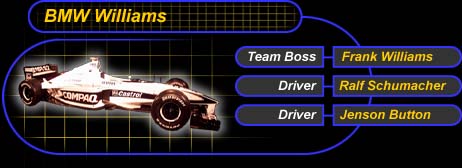
2000 Engine :
Engine Design 10-cylinder V-design
normal aspiration engine
Cylinder angle: 72 degrees
Capacity: 2998 cc
Valve: Four per cylinder
Valve Drive: Pneumatic
Engine block: Aluminium, wet
cylinder lines
Cylinder head: Aluminium
Crankshaft: Steel
Oil System: Dry sump lubrication
Engine management: BMW
2000 Car
Transmission: WilliamsF1
semiautomatic
Clutch: AP
Chassis: Carbon Aramid epoxy
composite, manufactured by WilliamsF1
Suspension: WilliamsF1
Steering: WilliamsF1
Cooling system: Two water
radiators, two oil radiators either side of the chassis
Brakes: Carbon discs and pads
operated by AP calipers
Lubricants: Castrol
Fuel: Petrobras
Wheels: O.Z.; 13x12 front, 13x13.7
rear
Tyres: Bridgestone Potenza
Spark Plugs: NGK
Cockpit Instrumentation:
WilliamsF1 digital data display
Steering Wheel: WilliamsF1
Driver's seat: Anatomically formed
in carbon/epoxy composite material with suede covering
Extinguisher Systems:
WilliamsF1/Safety Devices
Paint System: DuPont CENTARI
Front Track: 1460 mm
Rear Track: 1400 mm
Wheelbase: 3140 mm
Weight: 600 Kg including driver
and camera weight
Overall Car Length: 4540 mm
2000 Sponsors/Suppliers:
Compaq, Automotive Products Group,
Castrol, Komatsu, Petrobras, Andersen Consulting, Intel, Nortel
Networks, Reuters, Veltins, Bridgestone, MAN Nutzfahrzseuge AG,
Du Pont, Entranet, Matsuura, OZ Racing, QAD Europe, Willy Bogner
GmbH, Universal Studios







